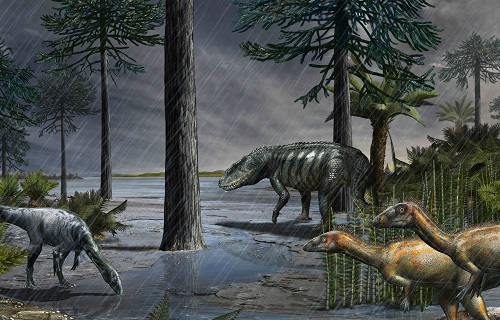
Scientists all around the world strongly believe that it was an asteroid impact 66 million years ago that could have eroded dinosaurs. But never known fact is how these creatures managed to become the most dominant species on the earth. A new study conducted by researchers at the Bristol University has now found the answer to this million dollar question.
According to the researchers, it was another mass extinction event that might have happened around 232 million years ago which resulted in the rise of dinosaurs. During the study, researchers learned that dinosaurs arose in the early Triassic period, about 245 million years ago, but they remained rare until a mass extinction event which happened 13 million years later.
The team found that before 232 million years ago, the planet witnessed a sharp rise in carbon dioxide levels due to an increased number of volcanic eruptions. Researchers refer to this particular event as Kamenskim pluvial episodes, and during this period, the temperature on the planet rose steadily causing acid rains which eventually led to the extinction of many pre-dinosaur species.
Unlike other living beings, dinosaurs made use of these conditions completely, and they slowly diversified. Expanding their dominance all around the planet, they later emerged as the most dominant predators which the earth has ever witnessed. The study report is now published in the journal Nature Communications.
"The discovery of the existence of a link between the first diversification of dinosaurs and a global mass extinction is important. The extinction didn't just clear the way for the age of the dinosaurs, but also for the origins of many modern groups, including lizards, crocodiles, turtles, and mammals – key land animals today," said Mike Benton, the study's co-author.
During the study, researchers analyzed rocks located in an Italian mountain range known as the Dolomites. Scientists succeeded in finding dinosaur footprints in these rocks, and it helped them to establish the point in time when they became dominant.
Later, the scientists compared these footprints with the first dinosaur fossils discovered from Argentina and Brazil. Further analysis of these fossils revealed that dinosaurs became prevalent in Brazil and Argentina at the same time which indicates that the explosion has happened globally.
"We were excited to see that the footprints and skeletons told the same story. We had been studying the footprints in the Dolomites for some time, and it's amazing how clear cut the change from 'no dinosaurs' to 'all dinosaurs' was," said Massimo Bernardi, lead author of the study.
The evidence is provided to match the two events – the mass extinction, called the Carnian Pluvial Episode, and the initial diversification of dinosaurs, said researchers. The point of explosion of dinosaurs matches the end of the Carnian Pluvial Episode, a time when climates shuttled from dry to humid and back. It was long suspected that this event had caused upheavals among life on land and in the sea.
In 2015, dating of rock sections and measurement of oxygen and carbon values provided the missing link showing that there were massive eruptions in western Canada, represented today by the great Wrangellia basalts.
There were four pulses of warming and climate perturbation, all within a million years or so. This must have led to repeated extinctions. reasoned out co-author Piero Gianolla from the University of Ferrara.









